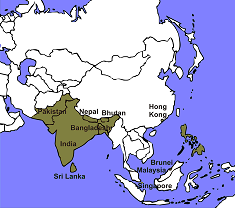Hong Kong
India
Malaysia
Philippines
Singapore
|
The spread of English to areas where no English-speaking communities had previously existed, including South-Asia, Southeast-Asia, etc. is said to have the greatest effects on the sociolinguistic profile of English. Malaysia belongs to the countries of the Outer Circle wherein English is institutionalized as an additional language and learned as a second language (L2).
Malaysia consists of two parts separated from each other by the South-China Sea: Peninsular Malaysia and Sabah and Sarawak on the island of Borneo. The population is about 26 million comprising Malays (60%), Chinese (25%), Indians (7%), and the remaining consisting of other ethnic and indigenous communities in West and East Malaysia. Malays are generally homogeneous in terms of language, the vast majority speaks Malay. |
 |
The Chinese are divided according to the dialectal groups they belong to. The Indians speak a number of different dialects such as Tamil and Malayalam. The language situation is diverse with at least 80 languages spoken in the country. Currently, the mastery of the English language is much encouraged at all levels of education and English is needed in the commercial and business sectors.
The reason for the spread of English in Malaysia was the colonial expansion of Britain which resulted in settlements of English speakers in Malaysia. When the British came to colonize the country, they brought with them their culture and language. English was introduced as the medium of instruction in the primary and secondary schools. The first British colony was established in 1787 in Penang. From then on, the British slowly expanded their influence both politically and geographically. The establishment of the Straits Settlement, consisting of Penang, Singapore and Melaka, followed the Anglo-Dutch Treaty of 1824 by which the Malay Archipelago was divided into a British zone in the north and a Dutch zone in the south.
Malay was made the official language in 1957, initially termed Bahasa Malayu but renamed Bahasa Malaysia in 1969 to enable all ethnic groups to identify with it. English was termed the ‘second most important language’ and between 1957 and 1967, both Bahasa Malayu and English enjoyed almost equal status. In Sabah, English and Bahasa Malayu (Malay) continued to be the official languages until 1973. In Sarawak, English was the official language till 1985. After independence however, in 1970, Bahasa Malaysia was introduced as the medium of instruction. With the advancement in technology and science, English regained part of its lost status. Today, English permeated many areas in the Malaysian society and enjoys the recognition of being the second language after Bahasa Malaysia. Malay is solidly established as the official language of Malaysia, thus clearing the way for a new emphasis on the importance of English without posing a threat to the status of the official language in any way.
Malaysian English is a non-rhotic and syllable timed variety. Phonological features include vowel mergers, when different vowels are realized as one and the same (e.g. mitt and mat are both pronounced as mit). Accent shifts (when a different syllable is stressed) as in [ ] instead of ] instead of
[ ] also occur. Often consonants at the end of words are omitted. Examples include bes (from best) and relac (from relax) or spea (from speak). Also final consonant cluster reduction is a phenomenon often observed in Malaysian English. ] also occur. Often consonants at the end of words are omitted. Examples include bes (from best) and relac (from relax) or spea (from speak). Also final consonant cluster reduction is a phenomenon often observed in Malaysian English.
|
|